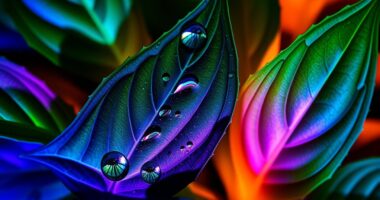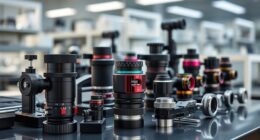Using far-red light to trigger flowering is a well-supported technique backed by science. It works by activating plant photoreceptors called phytochromes, which regulate flowering and development. By adjusting light quality with far-red, you can influence flowering times outside natural seasons. Although some challenges exist, treatments have shown consistent results in many plant species. If you want to understand how this method actually influences plants, there’s a lot more to explore.
Key Takeaways
- Scientific research confirms that far-red light activates phytochromes, reliably inducing flowering in various plant species.
- Far-red light influences plant hormonal pathways, aligning flowering signals with environmental cues.
- Manipulating light spectra, including far-red, offers a practical, controllable method to trigger flowering outside natural seasons.
- Excessive or uncontrolled far-red exposure can cause undesirable effects like shade avoidance, requiring careful management.
- The role of far-red light in flowering is well-supported by scientific evidence, debunking the myth and demonstrating its effectiveness.
Understanding the Role of Light in Plant Development

Light is a fundamental factor that influences how plants grow and develop. The light spectrum they receive determines key processes like photosynthesis and flowering. Different wavelengths trigger specific responses; for example, blue light promotes leaf growth, while red and far-red light affect flowering times. Plants rely on light to produce plant hormones such as auxins and gibberellins, which regulate growth and developmental stages. These hormones respond to light signals, guiding processes like stem elongation, leaf expansion, and flowering initiation. By understanding how the light spectrum interacts with plant hormones, you can better manipulate growth conditions. Proper light exposure assures healthy development and timely flowering, making light a critical tool in horticulture and agriculture.
The Science Behind Far-Red Light and Photoreceptors

Far-red light influences plant development by activating specific photoreceptors that detect this wavelength. These photoreceptors, known as phytochromes, are sensitive to light filtering through plant pigmentation, which affects their ability to respond. When exposed to far-red light, phytochromes switch between active and inactive forms, triggering signaling pathways that regulate growth and flowering. This process allows plants to interpret their light environment, especially the ratio of red to far-red light, which signals competition or open space. Your understanding of how light filtering impacts plant pigmentation helps explain how these photoreceptors function precisely. By detecting changes in far-red light, plants can adapt their development, making this a critical aspect of how light influences flowering and other growth processes. Additionally, phytochrome activation is essential for synchronizing flowering time with environmental conditions, ensuring successful reproduction.
How Plants Detect and Respond to Light Spectra

Plants detect and respond to different light spectra through specialized photoreceptors that sense specific wavelengths. These photoreceptors enable you to perceive and react to various light signals, guiding processes like germination, growth, and flowering. The diversity of plant photoreceptors, including phytochromes, cryptochromes, and phototropins, allows plants to interpret a broad range of light spectrum manipulation. For example, phytochromes primarily detect red and far-red light, helping plants gauge light quality and duration. Cryptochromes respond to blue and UV light, influencing growth and development. This diversity lets plants finely tune their responses to environmental cues, ensuring survival and reproduction. By understanding how plants perceive different spectra, you can better manipulate light conditions to influence plant behavior.
Practical Applications of Far-Red Light in Horticulture

Far-red light can help you control flowering schedules to meet market demands more effectively. By adjusting light conditions, you can optimize plant growth and make sure flowers develop at the right time. Additionally, using far-red light can improve energy efficiency, saving you costs while maintaining healthy plants. Incorporating best anime movies into your planning can also provide inspiration for creative horticultural projects.
Enhancing Flowering Timing
By manipulating light quality, horticulturists can effectively control the timing of flowering in various crops. Far-red light helps synchronize flowering, making it more predictable and efficient. To achieve this, you must consider factors like light pollution, which can interfere with plant responses, and plant genetics, which influence sensitivity to light cues. Properly timed far-red exposure can accelerate or delay flowering, optimizing harvests. Use the table below to understand key variables:
| Variable | Effect on Flowering Timing |
|---|---|
| Light Pollution | Disrupts flowering cues |
| Plant Genetics | Determines responsiveness to far-red |
| Timing of Exposure | Controls initiation of flowering |
Adjusting these factors guarantees more precise flowering schedules, improving crop yields and quality. Additionally, understanding herbal plant properties can aid in developing complementary growth strategies.
Optimizing Growth Conditions
Harnessing far-red light in horticulture extends beyond controlling flowering timing; it offers practical ways to optimize overall plant growth conditions. By adjusting light spectra, you can influence plant morphology, encouraging taller or more compact growth as needed. Incorporating genetic modification techniques allows you to develop plant varieties better suited to far-red light, enhancing growth responses. Nutrient optimization complements this by ensuring plants receive the essential elements for healthy development under modified light conditions. Proper light management can improve photosynthesis efficiency, leading to stronger stems and lush foliage. Innovative planter designs can also be integrated to optimize space and light exposure in various growing environments. When combined, these strategies help create an environment that maximizes plant vitality and yield. Using far-red light thoughtfully enables you to fine-tune growth conditions, resulting in healthier plants and more consistent production outcomes.
Energy Efficiency Benefits
Utilizing far-red light in horticulture can substantially reduce energy consumption while maintaining ideal plant growth. By integrating far-red LEDs, you optimize light spectra, allowing plants to grow efficiently with less overall energy. This targeted approach leads to significant cost savings, as you don’t need to run high-intensity lighting for extended periods. Far-red light enhances photoreceptor activity, promoting flowering and growth with less electricity. Additionally, its use can shorten growth cycles, further decreasing energy costs. This efficient use of light not only lowers your operational expenses but also minimizes environmental impact. Overall, adopting far-red lighting strategies helps you achieve healthier plants while making your energy consumption more sustainable and cost-effective. Incorporating light spectrum optimization techniques, such as targeted spectral tuning, can further enhance plant responses and overall efficiency.
Scientific Studies and Experimental Evidence

Recent scientific studies confirm that far-red light effectively triggers flowering in various plant species. These experiments provide verified evidence showing how specific light wavelengths influence developmental stages. Understanding these findings helps you apply the technology more accurately in your horticultural practices.
Experimental Results Overview
Numerous scientific studies have demonstrated that far-red light can effectively induce flowering in various plant species. Researchers have used photoperiod manipulation by adjusting light spectra to extend or shorten the day, triggering flowering responses. Some experiments combine far-red light with specific light durations, showing faster flowering times compared to traditional methods. Additionally, genetic modification techniques have been employed to enhance a plant’s sensitivity to far-red light, increasing flowering efficiency. Results consistently indicate that targeted light treatments influence developmental pathways, leading to early flowering without extensive changes to growth patterns. These experimental studies provide strong evidence that, under controlled conditions, far-red light acts as a reliable trigger for flowering, supporting its potential application in horticulture and agricultural practices. Understanding photoreceptors plays a crucial role in grasping how plants perceive and respond to light cues, further explaining the mechanisms behind these flowering responses.
Verified Scientific Findings
Scientific studies have provided compelling evidence that far-red light reliably triggers flowering across various plant species. Historical anecdotes reveal that ancient farmers observed plants flowering more quickly when exposed to specific light conditions, hinting at a long-standing connection between light and flowering. Modern experiments confirm this, showing that far-red light influences phytochrome activity, which controls flowering signals. These findings challenge cultural beliefs that flowering depends solely on seasonal cues, demonstrating instead that light quality can directly induce flowering. Multiple scientific investigations have documented consistent results, reinforcing the idea that far-red light isn’t just a myth but a practical tool supported by rigorous research. This evidence bridges historical observations and current science, validating the use of far-red light to control flowering in horticulture. Additionally, automation in agriculture plays a role in precisely delivering light treatments, further optimizing flowering responses.
Limitations and Considerations for Using Far-Red Light

While far-red light can effectively induce flowering, there are important limitations and considerations to keep in mind. One issue is shade avoidance, where plants interpret excess far-red as competition, causing unwanted elongation rather than flowering. Light pollution from outdoor sources can also disrupt the precise light schedules needed, leading to inconsistent results. Additionally, overexposure may trigger stress responses or hinder plant health. To better understand these factors, consider this table:
| Limitation | Impact | Mitigation |
|---|---|---|
| Shade avoidance | Unwanted elongation, delayed flowering | Use controlled environments, monitor light levels |
| Light pollution | Disrupted flowering cues | Shield grow areas from external light sources |
| Overexposure | Stress, poor growth | Adjust light duration/intensity |
| Species variability | Different responses | Research species-specific light needs |
| Cost and energy use | Increased expenses | Optimize light schedules for efficiency |
Furthermore, understanding the professional camper conversion services can help optimize the use of space and light inside converted vans for indoor gardening or plant cultivation.
Frequently Asked Questions
Can Far-Red Light Induce Flowering in All Plant Species?
You might wonder if far-red light can induce flowering in all plant species. The truth is, it doesn’t work equally across the board due to species variability. Different plants respond uniquely to the light spectrum, with some needing far-red exposure to trigger flowering, while others don’t. So, you can’t assume far-red light will universally induce flowering; understanding each plant’s specific light response is essential for success.
How Does Far-Red Light Interact With Other Environmental Factors Affecting Flowering?
Ever wondered how far-red light works with other factors to influence flowering? You see, it interacts with light intensity and plant photoreceptors, like phytochromes, to signal when a plant should bloom. When combined with proper light cycles and environmental conditions, far-red light can enhance or inhibit flowering. So, it’s not just about one factor but how these elements work together that determines flowering response.
Are There Long-Term Effects of Using Far-Red Light on Plant Health?
You might wonder if using far-red light has long-term effects on plant health. While it can influence flowering, excessive or improper use may cause plant stress, weakening your plants over time. Additionally, it can affect photosynthetic efficiency, possibly reducing growth and vigor. To keep your plants healthy, use far-red light carefully, balancing it with other light sources and environmental factors, and monitor for signs of stress regularly.
What Are the Energy Costs Associated With Using Far-Red Light for Flowering?
Imagine your plants as little factories, constantly consuming energy. Using far-red light for flowering increases energy consumption because it requires additional lighting, which can raise your electricity costs. While it may boost flowering, it’s important to contemplate cost efficiency. You might find that the extra energy used isn’t always justified by the results, especially if your goal is to minimize operational costs. Balancing energy costs and plant health is key.
Is There a Optimal Duration or Timing for Far-Red Light Exposure?
You should focus on optimizing the timing and duration of your light exposure to achieve the best results. Typically, a period of around 15-30 minutes of far-red light at specific times during the day works well. Consistent timing helps your plants respond effectively, so experiment with light exposure duration and schedule it to align with your plant’s natural growth cycle. Proper timing optimization can enhance flowering without unnecessary energy use.
Conclusion
You now know how far-red light can influence flowering, but did you know that some studies show plants exposed to it flower up to 20 days earlier? While it’s not a magic fix, understanding how to harness this light spectrum can boost your gardening success. Just remember, balancing far-red with other light types is key. By experimenting wisely, you can turn this scientific insight into real growth advantage in your green space.









